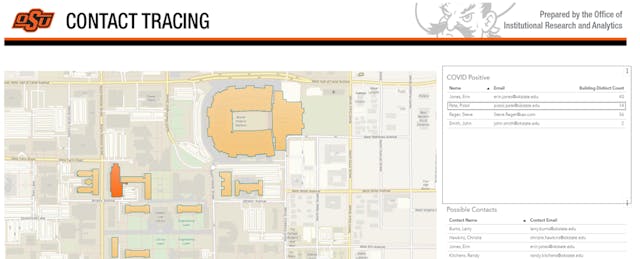As students and professors move across campuses, they leave plenty of digital traces—such as when their smartphones connect to Wi-Fi hotspots, or when they swipe their keycards to unlock buildings or enter dorm rooms.
Some campus officials plan to use that data to try to contain COVID-19 when campuses reopen in the fall. That information, they say, can be useful to health officials trying to track down people who have come in contact with students or professors infected with the virus.
But tapping into such data systems is unusual, if not unprecedented, and some worry about whether the practice overly invades personal privacy.
One campus embracing the approach is Oklahoma State University, which plans to lean on data from its 5,100 Wi-Fi access points, as well as card-swipe data and class attendance records as part of its contact-tracing program when students return to campus next month.
The plan is to work with the university’s health services and the local health department. Once a person at the university is known to be positive for COVID-19, the university’s institutional research office will plug that name into its data system. The system will then generate a list of others on campus who have come in contact with the person for at least 15 minutes in the past 48 hours, says Christie Hawkins, associate vice president for administration and finance and director of institutional research and information management at Oklahoma State.
Being on that list will have no immediate impact or consequence. (It will not, for instance, lead to automatic quarantine.) But the information will be used by officials doing manual contact tracing as they try to identify those at risk.
“Our role is really to speed up the process of finding out who [an infected] person has come in contact with so health officials can respond,” says Hawkins. “We are doing everything we possibly can to make sure that our campus, students, faculty and staff are safe and healthy.”
Often, students don’t even know the name of the person sitting next to them in class, which can make it tough to identify people who an infected person potentially exposed, adds Larry Burns, assistant director of institutional research and information management at the university.
Officials say relying on technology that people already use, rather than asking them to download a contact-tracing app developed by the likes of Apple and Google, offers a more convenient way to support contact-tracing efforts. After all, most students carry smartphones attached to the campus Wi-Fi network, or use laptops in class that connect to campus hotspots.
The university is using a data analytics service developed by SAS, an analytics and software company. University officials say their system will be able to create visualizations that show public spaces on campus where an infected person may have spent time before they were quarantined. “We can then use that type of visual to see if there’s an area on campus where there’s been numerous people that have been in contact, and if there’s areas that need deep cleaning,” says Hawkins.
Officials plan to inform the campus community about the tracing effort, and notify users when they log into the network that “OSU explicitly reserves the right to share necessary information from its computing system with appropriate authorities during a health and/or public safety emergency.”
There will be no way to opt out, other than by not connecting to the campus network.
Balancing Health and Privacy
That seems to go against a best-practice recommended in a recent report by EAB, an education consulting firm, which says the use of contract-tracing apps should be voluntary. That said, the report and other experts note that participation in any tracing program must be widespread to be effective.
Iris Palmer, senior advisor for the Higher Education and Workforce, Education Policy Program for New America, told EdSurge that Wi-Fi access data might not be precise enough to be effective for contact tracing. And she worried about the potential for privacy problems as well.
“There’s always tradeoffs to using this data,” she said. “As long as you’re really, really transparent with students, it might be OK, but I do think you need to give people an option to opt out because it is very invasive.”
Hawkins, of Oklahoma State, says the university is taking extra steps to safeguard data used in the project and to follow federal student privacy and medical privacy laws. She says the university will only keep the data for one month, and then it will be deleted.
She stressed that the plan is to discontinue the tracing effort as soon as the pandemic is under control. “This isn’t an ongoing initiative—we’re not going to continue to track Wi-Fi,” she added. “These are unprecedented times that justify the need to utilize this data.”
While many campuses could enact a system like the one OSU is building, it appears to be rare, if not one of a kind.
Shaun Barry, global leader for government, healthcare, and utilities at SAS, the data analytics company working with the university, says that privacy concerns, and the fact that some campus networks are not set up to identify the locations of users with much accuracy, have kept most colleges from adopting the approach.
But already, he said, many colleges are tapping into their student-record systems as they set up contact tracing programs so that they can quickly look up things like which classes a student is enrolled in. “Just to know that [a student] is in Alumni Hall in Classroom 101, and that they’re supposed to be there on Monday, Wednesday and Friday from 9 am to 11 am … can make sure those contact tracing interviews are better and faster.”


